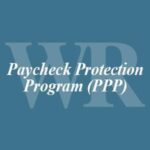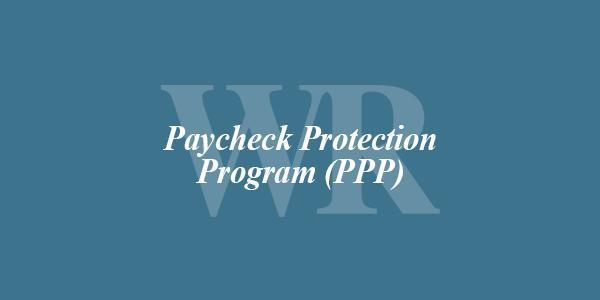
PPP Update- New IFR on Forgiveness- Good News for Borrowers
June 27, 2020
Healthcare Update- Update to the Provider Relief Funds’ Reporting Requirements
July 25, 2020PPP Update- Changes still coming?

It is coming up on a month since our last PPP update going over the changes made through the PPP Flexibility Act. Since then we have continued to advise clients on their PPP loans given their specific circumstances but, in reality, nothing has changed. There hasn’t yet been any new guidance and we haven’t heard of any banks starting to accept and process loan forgiveness applications. What is going on however, are discussions and negotiations in Washington D.C about new legislation that would impact the PPP. In this email we will go over what we are seeing and hearing might happen, some of the questions we are still not sure about, and our current advice for clients regarding their PPP loans.
What Is Being Discussed
Deductibility of PPP Expenses
The House of Representatives has passed The Heroes Act which includes making expenses paid with PPP loans that are forgiven deductible. As a reminder, on April 30, 2020, the IRS released Notice 2020-32 which provides that expenses paid by a forgiven PPP loan are non-deductible. The Heroes Act specifies that the deductibility of expenses “shall be determined without regard to whether any amount” of PPP funds are forgiven. This would be great news for borrowers (and accountants). We will wait and see what happens when the bill is in the Senate.
Loans Under $150k “Automatically” Forgiven
The Senate bill known as the “Paycheck Protection Small Business Forgiveness Act” has been introduced. This bill gives “automatic forgiveness of a paycheck protection loan that is not more than $150,000 if the recipient submits a one-page form. Further, it prohibits any enforcement or other action against a lender relating to loan origination, forgiveness, or guarantee based on the lender’s reliance on certifications or documentation submitted by a loan applicant or recipient.” While this bill still needs to pass the Senate and then move to the House, there is strong support for this from banks and the small business community. Banks don’t want to have to process forgiveness applications from the millions of small and micro businesses that received loans, and smaller businesses may have more difficulty pulling together all of the information to complete the full forgiveness application.
As mentioned in the opening paragraph, banks are not yet accepting loan forgiveness applications. It is our thought that banks may wait to see if this legislation passes before starting to process forgiveness applications in order to avoid being flooded by borrowers that could be automatically forgiven.
Second PPP Loans?
In case borrowers aren’t having enough fun dealing with their single PPP loan, last week at the House small business committee hearing the idea of allowing small businesses and businesses with significantly reduced revenues to apply for a second PPP loan was discussed. Several politicians have publicly floated this idea over the last few weeks. The ideas we’ve heard are to allow businesses with less than 100 employees and qualifying businesses with more than 50% reduction in revenue to apply for a second PPP loan up to $2 million. Currently there is about $130 billion of PPP funds remaining and increasing that has been discussed if second loans are allowed. This is in the very early stages but we will track any progress.
What We Still Don’t Know
FTE Levels Maintained for the Full 24-Weeks?
In our e-blasts last month we touched on this and we are still not 100% sure how the FTE calculations will be handled. We discussed considerations for using the new 24-week covered period vs an 8-week covered period. The perceived risk in using the 24-week period was not being able to maintain FTEs and/or salaries and wage levels for the entire 24 weeks, thus reducing forgiveness. The most recent IFR reduced this concern by stating that a borrower does not need to wait until the end of the full 24-week period to apply for forgiveness, and that wage rates can be calculated at the earlier of the end of the 24-week period or the application date. What the IFR does not address is if the FTE measurements can be made at the earlier of the end of the 24-weeks or the application date. This leaves us with the question of if a company must maintain FTE levels through the full 24-weeks (assuming they do not qualify for any of the FTE Safe Harbors). While many of our clients appear to qualify for the FTE Safe Harbors which means a reduction in FTEs will not affect their forgiveness, there are some companies that this issue applies to. We may just have to wait and see how banks interpret this as they process applications. It may also be a moot point as we may get past the 24-week period before banks start accepting applications (hopefully not).
Our Position/Advice
While we recognize many of our clients want to get their PPP loan experience over and behind them, we are still in a holding pattern. There are potential changes that will impact borrowers (likely positively) and banks. With the first payments on these loans not being required until next June at the earliest, there is no reason to be stressed out or to rush through this. Borrowers should continue to track qualified PPP expenses and keep records of the payments. As banks begin notifying you that you can submit your forgiveness applications, please share those notifications with us. We are ready to help guide you and put the information together for you for your forgiveness application.
We will continue to monitor changes in PPP guidance and rules and will do our best to keep you informed.
If you have questions or would like to strategically discuss your situation relative to PPP loan forgiveness, we are here to help. Reach out to your WR Partner or your relationship manager. You can also email our COVID-19 task force for assistance.


